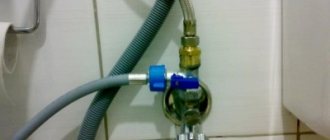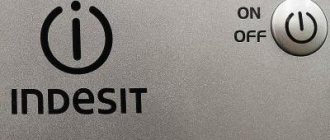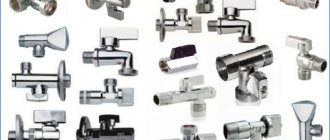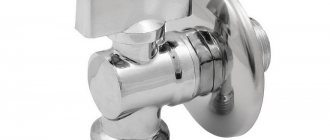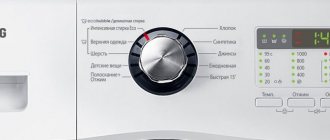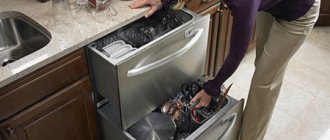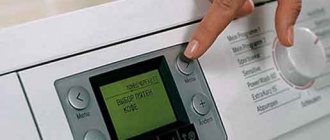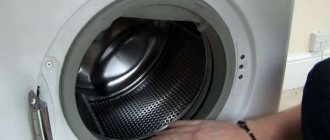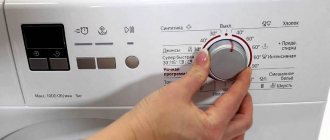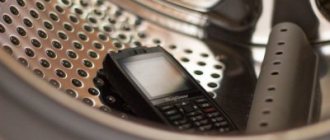Choosing an automatic washing machine is a responsible matter, but it is equally important to correctly connect it to the internal communications. Particular attention should be paid to the electrical part. You need to choose a reliable socket, install it correctly, select the correct wire cross-section for the washing machine and perform the installation efficiently. Most often, wiring is done during a major renovation of an apartment, but if necessary, you can lay a new cable immediately before installing new household appliances.
Features of connecting the washing machine to the electrical network
Like any other electrical appliance, a washing machine consumes electricity. Moreover, it belongs to the class of high-power consumers, as a result of which the connection must be made in strict compliance with a number of rules.
It is strictly forbidden to connect the washing machine:
- to a socket with visible damage;
- to electrical wiring made with a cable of insufficient cross-section;
- through extension cords or adapters;
- using a tee to a socket with a high-power electrical appliance already connected.
To protect the washing machine from possible breakdown, and yourself from a serious accident, you should select a separate outlet for connection, designed to operate in conditions of high humidity. The connection should be made using a large cross-section wire, and it should not come out of the nearest junction box, but directly from the panel. Otherwise, when the engine is turned on at maximum speed, the wire insulation may melt, which in turn can cause a fire.
If the owner plans to install several powerful devices in one room, for example, a washing machine with a dryer and a dishwasher, it is not necessary to lay a separate wire for each of them; it is enough to lay a copper wire, the cross-section of which is taken “with a reserve”, and wire it into two sockets in place.
How to choose an RCD
Of course, before purchasing, the question will immediately arise - which machine should be installed on the washing machine? To answer this, let's look at the standard characteristics. Popular machine models consume 2 kW, which exceeds the 10A mark (read more about the power and energy consumption of washing machines here). Based on this, the value of the power-cutting device or automatic circuit breaker should not exceed 10A; conventionally, these parameters correspond to 16 amperes.
Experts consider leakage current to be one of the most important parameters of the machine. It is with him that the main interaction of the RCD occurs. For recently completed wiring, a machine with a leakage current rating of 10 mA is perfect. In other words, the difference between the currents in the phase and neutral conductors should not be less than 10 mA, otherwise the device will not break the circuit. If the wiring is used for many years in a row, then it is better to use a 30 mA RCD. This will help avoid false positives.
The manufacturing company is a rather significant factor. Based on this criterion, sensors are divided into expensive ones - Legrand, ABB and cheap ones - IEK. These companies are the most popular and reputable in the consumer electronics market. Don’t try to save money: of course, the Chinese analogue will cost even less, but it will never be able to guarantee true European quality. The wrong choice of RCD can lead to the fact that you will constantly have plugs knocked out when you turn on the machine.
Selecting a wire to connect a washing machine
The reliability and durability of electrical wiring directly depends on the quality of its components. First of all, this applies to the wire. The main criteria for its selection are as follows:
- number of cores;
- conductor material;
- cross-section of the current-carrying conductor.
According to technical regulations, a modern automatic washing machine must be grounded. To do this, it is equipped with a plug with special contacts, therefore, you will need a three-core wire and a corresponding socket.
Aluminum and copper wire are available for sale. It is not recommended to use aluminum to power large household appliances; the optimal choice is copper.
Last, but not least, the characteristic of the wire is its cross-section. The value of this parameter is selected based on the power of the connected device. It’s easy to find a correspondence table on the Internet; in general, for a standard household model with a power of 2.5 kW, a copper wire with a core cross-section of 2.0-2.5 mm2 is perfect.
Requirements for safe operation of electrical wiring
According to the PUE, a bathroom is defined as a room with high humidity, which places special demands on electrical wiring. This is due to the increased risk for people in the room to be exposed to electricity.
Electrical panels, switches, and switching connections must not be placed in the bathroom. Sockets must comply with a protection level of at least IP44 with high-quality grounding, an RCD or a potential equalization device. The cross-section of the grounding wire must be no less than the wire having the largest cross-section in the room. It is not allowed to lay wiring in an iron braid without insulation, as well as in metal hoses and pipes.
It is necessary to use a three-core wire for a washing machine with a cross-section corresponding to the power consumption of the device, according to the above calculation. It is a priority to use solid copper cable, as it is more durable in comparison with aluminum and requires a smaller cross-sectional size for the same load.
All actions related to electrical installation to connect the washing machine must be carried out with the wiring de-energized.
Additional wiring accessories
Having decided on the wire parameters, you can move on to auxiliary devices, without which it is impossible to connect the washing machine. Required:
- powerful socket;
- socket box with fasteners;
- terminals for connecting wires;
- residual current device (automatic);
- cable channel (in case of open installation).
Particular attention should be paid to the choice of outlet. First of all, it must be designed for a power exceeding the consumption of the washing machine, otherwise the material may melt, contact deterioration, failure, and possibly a fire. We also must not forget that the washing machine is usually installed in the bathroom; it is operated in conditions of high humidity, therefore, the outlet must be waterproof.
Other parts must be selected based on their quality. Even something as simple at first glance as a socket box significantly affects the durability and reliability of the wiring. There is no need to buy cheap plastic products; if heated, they will become a source of a pungent odor and may catch fire if the temperature rises too high. The same applies to the cable channel.
Despite the fact that automatic protection devices are required to be installed at the entrance to the apartment, it is worth spending a little money and installing a separate machine on the line going to the washing machine. It will work in the event of an excessively increased load on the wiring, prevent an accident, and other consumers in the apartment will not be de-energized.
The problematic proximity of copper and aluminum
Most older residential buildings typically use aluminum wire as the main wiring. Its direct connection to a copper cable is not allowed, because when interacting, these metals enter into a chemical reaction, as a result of which the contact point is oxidized, forming a dielectric film on the surface of the conductor. Such a connection quickly begins to heat up and, regardless of the thickness of the cross-section of the wire for the washing machine, especially under high load, inevitably leads to burnout of the contact pair. This can lead to equipment failure and even a fire. To avoid such a situation, specialized connecting clamps must be used to interface copper and aluminum conductors.
It is also now possible to calculate what wire cross-section is needed for a washing machine when using an aluminum three-core cable for power supply. With a declared load of 2.2 kW, its cross-section must be at least 3 mm2 for each thread.
Planning and marking
Before you get down to business, you need to choose the optimal location to install the outlet. It should be located in close proximity to the machine, but the distance to the shield must also be taken into account. Do not forget that the further the shield is, the more wire will be required, in addition, the more work on gating and subsequent sealing of the channel will have to be done.
The installation location of the socket, as well as the wire route, is marked with a marker directly on the wall. When planning a route, you must remember that the wire must run either strictly vertically or strictly horizontally. Violation of this rule can cause an accident; not knowing where the wiring is laid, you can drive a nail or tighten a screw extremely unsuccessfully.
Having finished marking, it is worth checking everything again, and at the same time making sure that there is a sufficient amount of wire and its cross-section is correctly selected. It is important to understand here that high-quality wiring for a washing machine is continuous wiring. There should be no connections or twists in the channel - these are potential fire points.
Calculation of wire cross-section
The first thing that needs to be calculated is the cross-section of the wire through which the socket/machine that powers the washing machine will be connected. The cross-sectional diameter is selected according to the possible peak load on the electrical network. That is, according to the maximum power consumed by the device (indicated in kilowatts or volt*amps). You can find out the parameters of a particular washing machine directly in the technical documentation.
It is recommended to adhere to the following scheme.
Table 1. Scheme for calculating the cross-section of wires.
| Maximum current consumption | Cross-section of power cable wires (copper), mm | Cross-section of power cable wires (aluminum), in mm |
| Up to 1 kW | 1 | 2.5 |
| Up to 2 kW | 1.5 | 2.5 |
| Up to 3.5 kW | 1.5 | 2.5 |
| Up to 4.4 kW | 2.5 | 4 |
| Up to 5.5 kW | 4 | 6 |
Most household models of washing machines consume from 2 to 3.5 kW . is valid only for a supply voltage of 220 V. Washing machines that require a connection to 380 V are not used for domestic use.
Is it possible to use a wire of greater thickness than indicated in the table? Although this will be additional costs, this option is acceptable. The main thing is to lay it through a cable channel, the internal volume of which will be filled to no more than 60% (to ensure normal heat removal, which complies with SNiP standards).
What happens if the wire turns out to be thin?
If the wire is thin, then:
Otherwise, using a wire that is too thin to supply power is a violation of fire safety rules. Active use of such an electrical network can indeed cause a short circuit and subsequent fire.
Tools and consumables
The list of tools that will be required to lay the wire to the washing machine is individual and directly depends on the material of the walls. In limestone or a thick layer of plaster, you can chisel a channel with a “classic” hammer and chisel; in the case of monolithic reinforced concrete, you cannot do without a grinder. In general, you should prepare the following for work:
- electric drill and concrete drills;
- grinder with a disc for stone;
- sharp mounting knife;
- wire cutters and pliers;
- several screwdrivers;
- indicator screwdriver.
Consumables, namely a copper wire of the required cross-section and a socket, have already been purchased, as well as everything that is needed for installation, but it’s worth stocking up on electrical tape just in case. Even if twisting is not planned, but with its help you can quickly fix the wire in the right place. A tube of regular silicone sealant wouldn't hurt either.
Availability of grounding
The presence of grounding for a washing machine is a mandatory requirement. This is indicated in the technical documentation and in any other connection instructions. Without grounding, the static voltage generated on the drum of an automatic machine can “break through” to the body, and even to water pipes and taps (especially if the entire water supply is on metal pipes).
Also, static voltage can damage the vulnerable internal components of the washing machine. Most often, control boards “suffer” from it. And repairing such a breakdown can cost half the cost of a new device. And, by the way, connecting the washing machine to the electrical network without grounding is a violation of the warranty conditions. If it fails, even due to a manufacturing defect, the manufacturer has the right to refuse to carry out repairs.
What should be the grounding? The standard currently used is TN-S . In old apartment buildings in the Russian Federation, TN-C . Is it possible to connect the machine to a network with such grounding? In theory, yes, but in practice, the protection will be inadequate. In this situation, the installation of a so-called PEN conductor (often called a “bus”) is required, with its division into channels N (zero) and PE (for grounding). Any electrician can handle this without any problems (it is prohibited to do this on your own, since it requires a partial change in the connection configuration in the switchboard).
As for the cross-sectional diameter of the grounding wire, in most cases 1 mm for copper and 2.5 mm for aluminum are sufficient. And if a regular three-wire wire is installed to connect the power supply to the washing machine, then the cross-section will be the same as that of the supply wiring.
Is it possible to ground the water pipe or radiators? In no case, as this will lead to the spread of static to the entire water supply or heating pipeline in an apartment building. And if the wiring is also installed with a residual current device (RCD), then the grounding connection in such a non-standard way will lead to its automatic operation when the washing machine is turned on.
What to do in private houses where there is no grounding at all? Output it separately for the washing machine (you can also connect a boiler, pumping station, dishwasher to it - these are the devices that consume the most electricity in the house).
Mounting space for socket and groove
It is better to start chiseling from the recess for the socket. The optimal tool for this seems to be an electric drill with an attachment for drilling cylindrical holes. It is only important to choose a crown of a suitable diameter, focusing on the parameters of the socket box. If there is no such attachment, you can drill holes over the entire area of the future recess and carefully knock down the jumpers with a chisel. The recess will not be as neat, but the method is quite effective.
Next they move on to gating. Ideally, you can use a special tool for this – a wall chaser. It leaves behind a perfectly even groove; working with it does not require excessive physical effort. In the absence of one, you can get by with the same drill. Holes are drilled along the cable laying line with the minimum possible pitch, and the final formation of the groove is done using a grinder.
Sometimes you can do without dusty work at all; a cable laying channel will help out. It is enough to fix the box on the wall and lay the wire of the required cross-section inside it. It's quick and easy, but not always aesthetically acceptable.
RCD and machine power
The cable leading a separate line to the bathroom is connected to the indoor distribution panel through an emergency shutdown device (RCD).
The leakage current of the protective device for connecting lines when fast protection is needed should be 10 mA. This is due to the fact that the bathroom is characterized by high humidity, and therefore the room is classified as a high-risk area. A person feels the irritating effect of alternating current already at a value of 5-7 mA.
If the outlet in the bathroom is powered from a group line, the maximum leakage current for connecting the electrical wiring should be 30 mA. Such devices are cheaper than 10 mA, but do not operate as quickly.
For installation in private houses and apartments, models combined with a circuit breaker to protect the wiring - differential switches - are most often used.
Differential switches provide protection on three fronts:
- from power grid overload
- from exceeding the permissible current leakage value
- from short circuit on the line
If there is no stationary RCD in the electrical distribution panel in the apartment, a portable type RCD is used. They are connected to an existing outlet, and then the electrical equipment is connected.
Socket equipped with RCD
But the RCD itself is not a complete protection. To protect the wiring and the unit itself from short circuits, a separate residual current circuit breaker is installed.
Traditionally, a 16A machine is used. In any case, the operating current rating of the RCD must be one category higher than the rated current of the input circuit breaker.
Wire laying work
They start pulling the wiring from the panel. At the same time, it is important not to forget that an additional machine will be installed in it. Before starting installation, you need to mark the connection points of the conductors (phase, neutral, grounding), but you do not need to connect the terminals yet.
The wire is temporarily fixed inside the shield, placed in the prepared channel, and, if necessary, secured with plastic fasteners.
What not to do
It is strictly forbidden to use extension cords in bathrooms, especially those of dubious manufacture. Not only are they in no way protected from moisture, most of them do not have a grounding contact, and the cords are made of wire with a small cross-section.
Do not connect the grounding of the outlet to water supply and sewerage pipelines, heating radiators and building fittings.
The bathroom, as mentioned above, is a room with high humidity, where the effect of high voltage electric current is especially strong.
The cost of any mistake in connecting electrical equipment can be quite high, so you need to strictly follow the recommendations and not hope that nothing bad will ever happen.
Installing an outlet
After the wiring is laid along its entire length, you can install the socket. The sequence of actions is as follows.
- Installation of a socket box. To fix it, use the complete fasteners, but it wouldn’t hurt to additionally “seat” it with cold welding or sealant.
- The ends of the wire are inserted into the hole in the socket box.
- Unpack the socket and take out its inner part.
- The terminals are connected alternately: phase, neutral, ground. At the same time, you need to ensure that the ends of the wire are not too tight; do not forget that it is quite possible that the socket will have to be repaired.
- Using standard fasteners, the socket is securely fixed in the socket box. No play is allowed; it must “sit” motionless.
- Screw on the plastic cover.
After this, the wire is connected to the machine; of course, at the time of connection, the electricity in the apartment must be turned off.
Connection point installation technology
At the time of installation of the socket, there should already be a machine or RCD installed in the electrical panel, and the wire itself should be routed into the bathroom.
Before proceeding with the installation of the connection point, you should make sure that the wire is not live by touching the ends of the cable stripped from the braid with an indicator screwdriver
Step #1 - laying the cable and installing the socket box
To perform hidden wiring in the wall cavity, a groove is made using a hammer drill. It is laid along the shortest path under the ceiling parallel to the floor surface.
The line to the socket is lowered straight down perpendicularly. The wiring is fixed in the grooves using dowel clamps.
To mark the location of the socket, the device body is applied to the center of the laid strip. Use a marker to make marks for drilling the hole. Having marked the point of placement of the socket, using a hammer drill equipped with a D 68 mm crown, make a hole in the wall.
Using a hollow drill, you can quickly and economically make a large-diameter hole in the wall for installing a standard-sized socket box.
The walls of the hole made are cleaned of dust residues and crushed wall elements. A socket box is installed in the prepared seat.
The choice of socket depends on the type of wall. For installation in concrete, mounting blocks without any fixation elements are used. For drywall - plastic cups equipped with pressure plates to allow fixation on the back side of the sheet. You can read more about the technology of installing a socket box in another article.
Having fixed the socket box in the wall using presser feet, or by applying putty or alabaster solution to the surface, clean the internal cavity of the box and remove the wire
The installed socket box will contain a terminal block for connections to electrical wiring hidden in the wall.
Step #2 - Connecting the Terminal Block
Decorative elements are removed from the socket body, leaving only the terminal block. The fastening bolts at the terminals are loosened, with the help of which the bare ends of the connected wires will be fixed.
The ends of the electrical cable are stripped of braid using a cross-cutting knife or side cutter, pointing them in the opposite direction to the movement of the tool.
For ease of connection, the insulation of the supplied wires is made in different colors. The ground wire is painted in a green-yellow braid, the phase wire is presented with a red or brown sheath, and the neutral wire is in blue or blue insulation.
The ends of the wires removed from the plastic “glass” are brought to the contacts and inserted into the terminals. The phase and neutral wires are connected to the current-carrying terminals: phase on the right, neutral on the left. The grounding conductor is connected to the terminal designated by the abbreviation “PE”.
The grounding conductor is connected to the top or central terminal, equipped with “antennae” fixed on the device body
Under no circumstances connect the “zero” to the grounding terminal. Otherwise, if the working “zero” in the panel burns out, the reverse “phase” will break through on the body of the machine connected to the network.
The socket body with connected contacts is fixed to the socket box with screws or spacer tabs. After fixing the block, check the quality of the contact connections and the tightness of the bolts on the terminal blocks.
At the final stage, a decorative cover is installed.
Checking the quality of work
You can verify that the installation has been completed correctly using a test screwdriver; it can be successfully replaced by any household appliance powered by the mains, for example, a table lamp. If everything is fine, you can seal the channel and move on to finishing the walls.
Good wiring is a guarantee of safe operation of any household appliances: refrigerator, water heater, dishwasher and washing machine. Although laying wires and installing sockets is a rather complicated process, if you wish, you can do everything yourself. Of course, we must not forget that electricity is dangerous; if you have doubts about your own abilities, you should entrust the work to a master.
